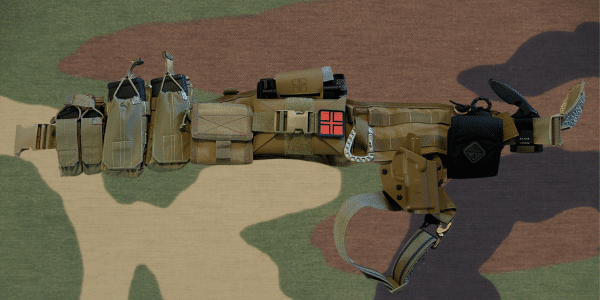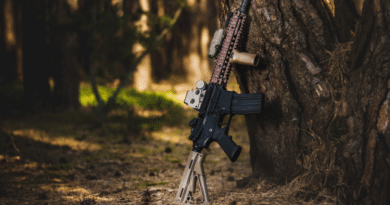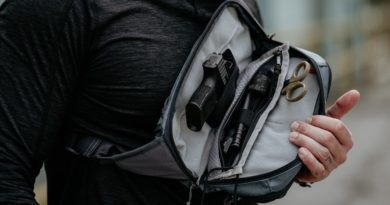Battle Belt Basics: A Guide to Options & Accessories
When it comes to tactical gear, finding the perfect setup with a battle belt can be quite a challenge. With battle belts becoming an increasingly popular choice for carrying essential equipment, understanding them better is crucial.
In this article, we’ll delve deep into the world of battle belts — from their types and key features to how you can customize one for your specific needs. Ready to transform your tactical readiness? Today we are going to provide you with all the details. Let’s dive in!
Key Takeaways
- A battle belt is a versatile piece of self-defense gear that allows you to carry essential tools and accessories like holsters, pouches, flashlights, and first aid kits.
- There are different types of battle belts available, including traditional belts, MOLLE belts, rigger belts, and Cobra belts. Each type offers its own advantages in terms of customization options and durability.
- Key features to look for in a battle belt include a quick-release buckle for easy removal, inner belts for support and stability, pouches for storage space, and anti-slip pads to keep the belt secure during movement.
- Essential accessories for a battle belt setup include pouches for organized storage of tools and equipment, holsters to securely carry firearms, dump pouches to quickly stow empty magazines or items during intense situations, magazine holders for spare ammunition accessibility, and first aid kits to address medical emergencies.
Table of contents
- Key Takeaways
- What is a Battle Belt?
- Understanding the Different Types of Battle Belts
- Key Features and Accessories to Look for in a Tactical Battle Belt
- Essential Outer Belt Accessories for a Battle Belt & War Belt
- How to Choose the Right Battle Belt or Gun Belt
- Start Setting Up Your Battle Belt or Duty Belt Today to Match Your Mission
- Battle Belt FAQs
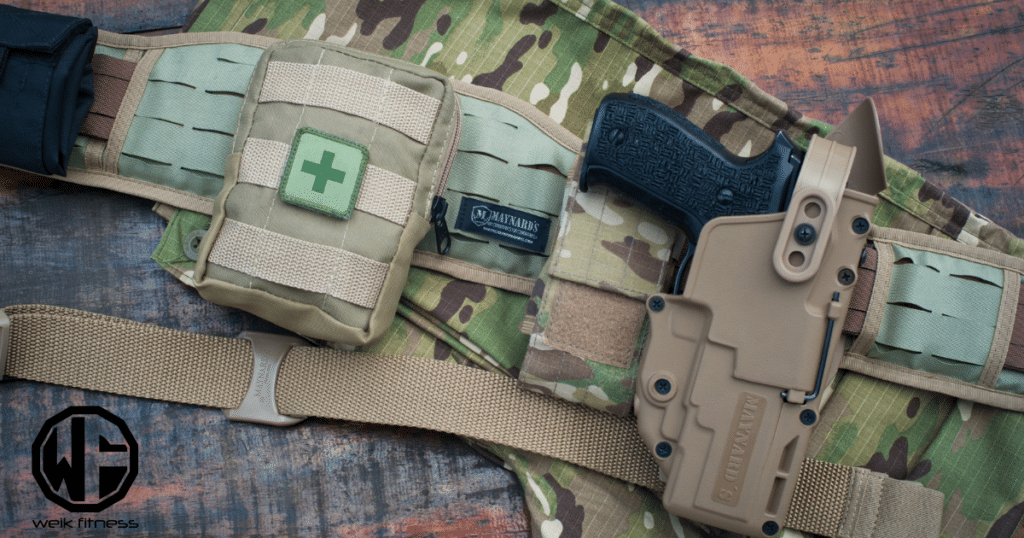
What is a Battle Belt?
A battle belt, also known as a war belt, is a versatile and essential piece of equipment for self-defense enthusiasts or tactical operators. It serves as an easily accessible platform designed to carry various tools and accessories such as holsters, pouches, flashlights, multi-tools, dump pouches for empty magazines, tourniquets (TQs), and even first aid kits (IFAK). This is a good belt that can easily be worn over your pants and existing belt or can be combined with a Velcro inner belt like a two-belt system.
Related Article: The History of Military Camo Patterns
Most battle belts come in a 1.5″, 1.75″, or 2″ belt.
This waist-worn gear can either be used standalone or in conjunction with other load-bearing systems like the chest rig or plate carrier. Typically, a battle belt is not something you weave through your belt loops.

What sets apart a battle belt from ordinary belts is its design, focusing on utility during intense situations. Many models are equipped with MOLLE webbing — a system that enables secure attachment of different gear.
The inner belt typically features nylon construction and Velcro hook and loop for firm fitting, where it secures your outer battle belt and helps distribute weight evenly across your waist, making it more comfortable to wear over long periods.
Popular among military personnel and shooting sports players alike, this highly customizable setup offers quick access to all your necessary items while keeping them organized on the go.
Understanding the Different Types of Battle Belts
There are several types of battle belts to choose from, including traditional belts that goes through your belt loops to MOLLE belts, rigger belts, and Cobra belts.
1. Traditional belts
Traditional belts, originally designed for holding up pants, have evolved into essential gear in the world of self-defense and firearms. These belts are made from sturdy materials such as nylon webbing or leather to provide long-lasting support and rigidity. Many also call these EDC belts or concealed carry belts.
In most cases, a traditional belt is used to carry holsters, mag pouches, flashlights, knives, or any other basic piece of kit you might need.
Related Article: Cloud Defensive MCH: A High Candela Retina Melter
However, unlike more advanced battle belt systems like molle belts or cobra buckle belts with laser-cut molle webbing for added versatility and customization options, traditional belts operate on simplicity.
They use conventional loops for attaching your chosen equipment. Thus, they lack the modularity that modern tactical gear offers but favor minimalism and ease-of-use instead.
2. MOLLE belts
MOLLE belts, an essential piece of kit for any self-defense enthusiast or firearms lover, stand out due to their versatility. With a MOLLE-equipped battle belt, you can easily adapt your setup as per your needs and preferences.
This type of belt system scores high on customization possibilities; the Modular Lightweight Load-carrying Equipment (MOLLE) design allows for a wide range of pouches and holsters to be attached securely.

Swapping out tools or adjusting the configuration becomes effortless with this nylon webbing feature, making these belts desirable among tactical gear enthusiasts. Whether it’s AR mag pouches, dump pouches, or first aid kits (IFAKs), everything finds its proper place on a molle belt — contributing to improved comfort and accessibility during use.
3. Rigger belts
Rigger belts are a popular choice for tactical use due to their strength and durability. These belts are typically made from nylon webbing, making them resistant to wear and tear. They feature a quick-release buckle system that allows for easy adjustment and removal in emergency situations.
Rigger belts provide a secure platform for attaching various pouches and accessories, allowing users to carry essential items while keeping their hands free. With their sturdy construction and versatility, rigger belts are a reliable choice for those looking to customize their battle belt setup.
4. Cobra belts
Cobra belts are a popular choice for battle belt setups. These belts feature a durable and secure cobra buckle, providing quick release and easy adjustment. With their rigid construction and heavy-duty materials, Cobra belts offer excellent stability and support when carrying gear.
They are compatible with MOLLE attachments, allowing you to attach pouches, holsters, and other accessories. Whether you’re an experienced operator or just starting out, a Cobra belt is a reliable and essential piece of equipment for your battle belt setup.
Key Features and Accessories to Look for in a Tactical Battle Belt
Look for a battle belt that has a quick-release buckle, inner belts for support, pouches for storage, and anti-slip pads to ensure a secure and comfortable fit.
1. Quick-release buckle
A quick-release buckle is a key feature to look for in a battle belt. This type of buckle allows you to easily and quickly remove the belt in case of emergencies or when you need to quickly access your gear.
It provides added convenience and ensures that you can easily take off or put on your battle belt with minimal effort. A quick-release buckle is an essential component for self-defense and firearms lovers who value ease of use and efficiency in their equipment setup.
2. Inner belts for support
Inner belts are a crucial component of a battle belt setup, providing essential support and stability. These belts are designed to be worn inside the outer belt and serve as a foundation for attaching various pouches and accessories.
The inner belt keeps the battle belt securely in place while distributing the weight evenly around your waist, ensuring maximum comfort during extended periods of wear. Look for inner belts with adjustable buckles and high-quality materials that offer durability and rigidity.
By using an inner belt, you can create a reliable platform for carrying your gear without compromising on mobility or convenience.
3. Pouches for storage
Pouches are an essential feature of a battle belt, providing storage for necessary items like extra magazines, tools, and first aid kits. These pouches can be easily attached to the MOLLE webbing on the belt, allowing for customizable placement and easy access.
With various sizes and configurations available, individuals can choose pouches that best suit their needs. Whether it’s pistol mag pouches or dump pouches for empty magazines, having the right storage options is crucial for staying prepared in any situation.
4. Anti-slip pads
Anti-slip pads are an essential feature to consider when setting up your battle belt. These pads are designed to keep your belt securely in place, even during intense movement or physical activity.
They provide a layer of grip between your belt and clothing, preventing it from sliding or shifting around as you move. This ensures that your gear stays exactly where you need it, allowing for quick and easy access to your pouches and accessories.
With anti-slip pads, you can have confidence that your battle belt will stay in place no matter what challenges you encounter.
Essential Outer Belt Accessories for a Battle Belt & War Belt
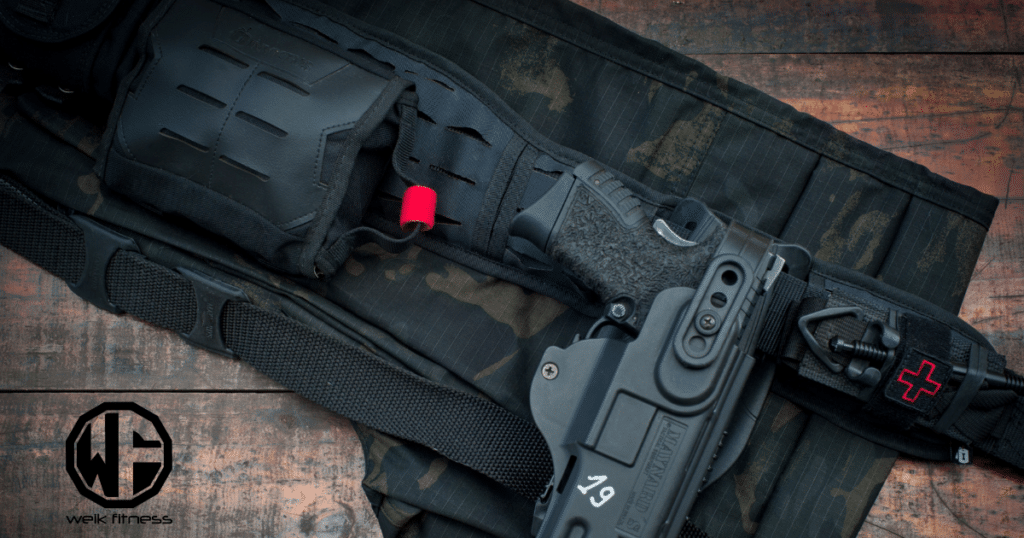
Pouches, holsters, dump pouches, magazine holders, and first aid kits are just a few of the essential accessories that can enhance your battle belt setup. Discover how these accessories can improve your self-defense and firearm options by reading more about them in our blog.
1. Pouches
Pouches are an essential part of any battle belt setup. They provide storage space for your gear, keeping everything organized and within easy reach. Whether you need to carry extra magazines, a first aid kit, or other tools, there are pouches available to suit your needs.

Look for pouches that are compatible with MOLLE webbing, as they can be easily attached and repositioned on your belt. Consider the size and number of pouches you’ll require based on your intended use and preferences.
Don’t overload your belt with too many pouches at once. Start with the essentials and add more as needed. Remember that comfort is key when wearing a battle belt, so choose pouches that won’t impede movement or become cumbersome during use.
2. Holsters
Holsters are an essential accessory for your battle belt setup. They provide a secure and accessible way to carry your pistol or other firearms. When choosing a holster, look for options that offer reliable retention and quick draw capabilities.
Safariland, G-Code, Tier1 Concealed, and T-Rex Arms are popular brands known for their quality holsters. Ensure that the holster you choose is compatible with your specific firearm model to ensure a proper fit and functionality.
Related Article: G-Code RTI Optimal Drop Pistol Platform: A Safariland Killer?
Whether you prefer a drop leg holster or one attached directly to your battle belt, having a reliable and well-designed holster is crucial for self-defense situations where quick access to your weapon is necessary.
3. Dump Pouches
Dump pouches are a crucial accessory for any battle belt setup. These pouches are designed to securely hold empty magazines or other items that need to be stowed quickly during intense situations.
With a dump pouch, you can easily and rapidly dispose of used magazines without the risk of losing them or fumbling around. Dump pouches typically feature a large opening and adjustable closure system, allowing you to quickly drop items into the bag without taking your eyes off the target.

They are essential for maintaining a clean and organized workspace while ensuring easy access to fresh ammunition when needed most.
4. Magazine Holders
Magazine holders are an essential accessory for a battle belt. These pouches securely hold extra ammunition, ensuring quick and easy access when needed. Whether you’re carrying pistol or AR magazines, there are various options available to accommodate your specific needs.
Magazine holders can be attached to the MOLLE webbing on the belt using straps or clips, allowing for customization and flexibility in placement. By having magazine holders on your battle belt, you’ll always have spare ammunition at the ready, keeping you prepared for any situation that may arise.
5. Individual First Aid Kits (IFAK)
Individual first aid kits (IFAKs) are an essential accessory for any battle belt setup. In the unpredictable world of self-defense and firearms, accidents can happen. Having a well-stocked first aid kit readily available can mean the difference between life and death in critical situations.
Related Article: Live the Creed — Impressive EDC & Battle Belt Med Kits
A good first aid kit should include items such as bandages, antiseptic wipes, gauze pads, medical tape, trauma shears, and even a tourniquet. It’s important to regularly check and restock your first aid kit to ensure it is always ready for use.
Your safety and the safety of those around you should never be compromised, so make sure to prioritize having a reliable first aid kit as part of your battle belt setup.
How to Choose the Right Battle Belt or Gun Belt
When choosing the right battle belt, consider your needs and intended use, determine your budget, look for quality materials and construction, find the right fit, and consider the weight and adjustability of accessories.
Ready to dive deeper into this topic? Keep reading!
1. Consider your needs and intended use for a battle belt
When choosing a battle belt, it’s essential to consider your needs and intended use. Think about the specific tasks you’ll be performing and the equipment you’ll need to carry. Are you looking for something lightweight and low-profile, or do you require more storage space? Will you primarily be carrying magazines, or do you need pouches for other tools like multi-tools (such as a Leatherman or Gerber) or a medical kit that includes things like tourniquets, chest seals, and combat gauze?
By identifying your requirements upfront, you can narrow down your options and find a battle belt that meets your specific needs.
Related Article: Leatherman Skeletool: The Best EDC Multi-Tool Ever Created
It’s also important to think about how you intend to use the belt. Will it be worn over clothing or directly on the body? Do you plan on running with it or engaging in other physical activities? Are you just larping with your battle belt or using it for airsoft battles with your buddies? Considering these factors will help ensure that the battle belt is comfortable to wear and won’t hinder your movement when in action.
Remember that finding the right balance between functionality and comfort is crucial when selecting a battle belt. So, take some time to assess your needs before making a purchase decision.
2. Determine your battle belt budget
Before diving into the world of battle belts and accessories, it’s important to determine your budget. Battle belts come in a wide range of prices, so knowing how much you’re willing to spend will help narrow down your options. If you want an entry-level battle belt that won’t break the bank, look for brands like 5.11 Tactical, Condor, or Tacticon. If you are fine with paying a little more, check out the options from HRT, HSG, Blue Force Gear, Haley Strategic, Wilder Tactical, Crye Precision, Viking Tactics, Tactical Tailor, Raptor Tactical, or something like a Grey Ghost Gear UGF battle belt.
As far as battle belts go, you honestly get what you pay for. For something of high quality that is American made (many times by a veteran owned company), it’s a “buy once, cry once” scenario. The entire belt is going to be solid and good to go, whereas some of the cheaper battle belts may not hold up as well undress the stress you put it under.
Keep in mind that while there are some affordable options available, investing in a higher-quality belt may be worth it in the long run for durability and performance. Take some time to assess your financial situation and decide on a budget that suits you best before making any purchases for your battle belt setup. If you don’t plan on needing to go to war with bullets whizzing past your ears and a potential grenade thrown at you, a battle belt that costs several hundred dollars may not be worth the investment.
3. Look for quality materials and construction
A battle belt is a crucial piece of equipment for self-defense and firearms lovers, so it’s important to look for quality materials and construction when choosing one. A well-made battle belt will be durable and able to withstand the rigors of tactical use.

Look for belts made from strong nylon webbing or laser-cut molle, as these materials offer both strength and flexibility. Additionally, pay attention to the stitching and overall craftsmanship of the belt.
High-quality construction means that your battle belt will last longer and perform reliably in any situation.
4. Find the right fit
To ensure optimal comfort and functionality, it is crucial to find the right fit for your battle belt. Consider factors such as your needs and intended use, budget, quality materials and construction, weight, adjustability of accessories, and overall comfort when making your selection.
A properly fitted battle belt will provide you with the support and accessibility you need during self-defense situations or firearms training exercises. Take your time to experiment with different configurations until you find the setup that works best for you.
Figure out what would fit you best and what you want to run. Do you want to run something like a low profile belt? Do you need suspenders? Would a 1.75-inch belt fit your hips better? What belt seems to stay in place while fitting your wants and needs? Do you need a rifle mag pouch, or are you just running pistol mags so that your rifle mags are on your chest rig? There are many factors to take into consideration.
5. Consider the weight and adjustability of battle belt accessories
When setting up your battle belt, it’s important to consider the weight and adjustability of the accessories you plan to attach. The last thing you want is a belt that feels bulky or uncomfortable when loaded with gear.

Look for accessories that are lightweight yet durable so that they won’t weigh you down during movement. Additionally, choose accessories that can be easily adjusted to fit your body size and shape.
Related Article: Stripped-Down Tactical — Embracing Minimalist Chest Rig Design
This will ensure a secure and comfortable fit, allowing you to move freely without any restrictions. By carefully considering the weight and adjustability of your accessories, you’ll create a battle belt setup that is both functional and comfortable for your self-defense or firearms needs.
Start Setting Up Your Battle Belt or Duty Belt Today to Match Your Mission
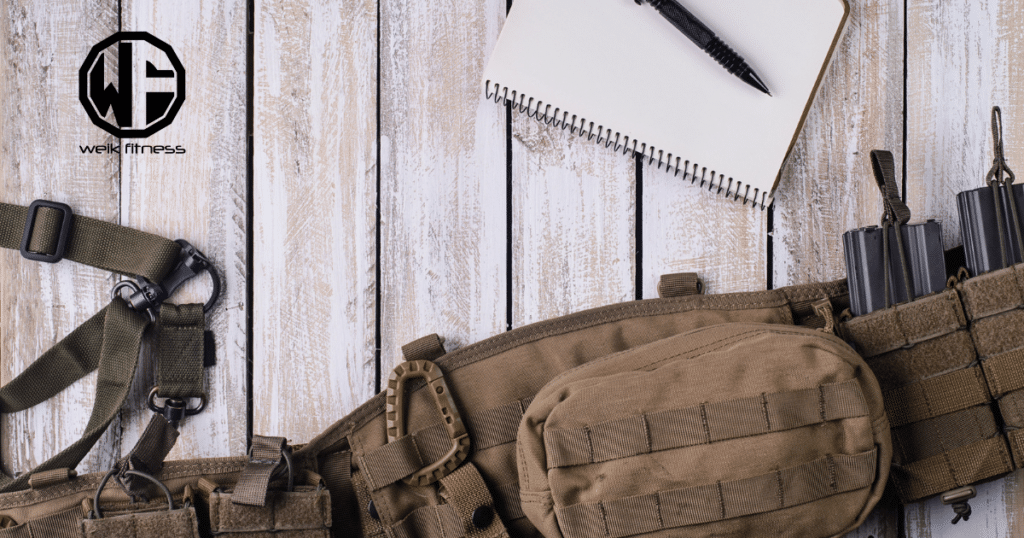
In conclusion, this guide has provided a comprehensive overview of battle belt basics, including different types and key features. By understanding the options and accessories available, individuals can customize their battle belts to suit their specific needs.
Whether you’re a self-defense enthusiast or someone who wants quick access to tools and equipment, a properly configured battle belt can be an invaluable piece of gear for your tactical arsenal.
So, go ahead and explore the possibilities that battle belts offer in terms of functionality, comfort, and readiness.
As a side note to close out this article, if you want to support our website and are in need of any tactical gear (or any product for that matter), anything you purchase using our links below will provide us with a small commission. We don’t charge for our free content and our goal is to keep it that way. We don’t have a Patreon account to put things behind a paywall, nor do we sell pics of our feet on OnlyFans.
If you choose to use the links below and make a purchase (at no additional cost to you), we greatly appreciate your support as it helps us continue to publish free content (like this article) on our website:
- Optics Planet (use code SAS5 at checkout for 5% off)
- Amazon
We have also partnered with CCW Safe. It’s the concealed carry coverage that I personally have for myself and my family in the event we need to defend our lives. Feel free to use our CCW Safe link to sign up and get some coverage to protect yourself and your family.
Also if you have a product you would like us to check out and potentially review, please contact us and let’s discuss.
Battle Belt FAQs
A battle belt, also known as a gun belt or war belt, is a tactical waist belt that provides space to mount gear and accessories for easy access.
A good battle belt often includes features like laser cut MOLLE compatibility for mounting equipment, Velcro inner lining for secure placement, and is typically low profile with ranger green or coyote brown color options.
Yes! The laser-cut MOLLE feature allows you to attach your mags, knife, drop pouches, and other accessories in any comfortable position on the entire length of the 1.75-inch or 1.5-inch wide belts.
Absolutely! Battle belts come in various patterns, including MultiCam black camo and standard MultiCam, aside from solid colors like coyote brown or ranger green.
500D Cordura fabric used to create your waistbelt ensures durability under extreme conditions, making it an important consideration when choosing your preferred molle-compatible tactical gear.
Brands such as HSGI and G-Code are recognized industry-wide due to their sturdy construction and well-designed models, fitting both amateurs’ needs as well professional demands equally.


*Disclosure: This article may contain affiliate links or ads, which means we earn a small commission at no extra cost to you if you make a purchase through these links. These commissions help support the operation and maintenance of our website, allowing us to continue producing free valuable content. Your support is genuinely appreciated, whether you choose to use our links or not. Thank you for being a part of our community and enjoying our content.
PLEASE CONSIDER SHARING THIS ON YOUR SOCIAL MEDIA TO HELP OTHERS LEARN MORE ABOUT THIS TOPIC.


